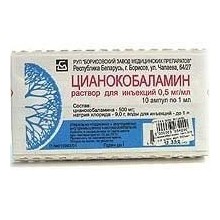



Cyanocobalamin has a hematopoietic, stimulating cellular metabolism effect. Cyanocobalamin is involved in the transfer of methyl fragments, the formation of choline, methionine, creatine, nucleic acids, the maturation of erythrocytes, contributes to the accumulation in the erythrocytes of compounds containing sulfhydryl groups.
Anemia (Addison-Biermer, alimentary macrocytic, iron, hemorrhagic, aplastic caused by toxicants and drugs), cirrhosis, hepatitis, myelosis, polyneuritis, sciatica, trigeminal neuralgia, amyotrophic lateral sclerosis, cerebral palsy, multiple sclerosis, disease Down's, skin diseases, peripheral nerve injuries.
1 ml solution for injection contains cyanocobalamin (vitamin B12) 500 mcg.
No customer reviews for the moment.
With Addison-Birmer anemia - 100-200 mcg every other day; with Addison-Birmer anemia with symptoms of the funicular myelosis and with macrocytic anemia with disorders of the nervous system - 500 mcg or more per injection (for the first week every day, and then with intervals between injections up to 5-7 days). At the same time prescribed folic acid. In the period of remission in the absence of symptoms of the funicular myelosis, Cyanocobalamin is administered for maintenance therapy at 100 μg 2 times a month, and in the presence of neurological phenomena, 200-400 μg 2-4 times a month.
In case of iron deficiency and post-hemorrhagic anemias - 30-100 mcg 2-3 times a week; with aplastic anemia (especially in children) - 100 mcg before the onset of clinical and hematological improvement; with nutritional anemia in children at an early age and in premature babies - at 30 μg / day for 15 days.
In diseases of the central nervous system and neurological diseases with pain, cyanocobalamin is administered in increasing doses from 200 to 500 mcg per injection, and when improving the condition - 100 mcg / day; course - up to 2 weeks.
With traumatic lesions of the peripheral nerves - 200-400 μg every other day for 40-45 days.
With hepatitis and cirrhosis of the liver - 30-60 mcg per day or 100 mcg every other day for 25-40 days.
With dystrophy in young children, Down's disease and cerebral palsy - 15-30 micrograms per day.
When funicular myelosis, amyotrophic lateral sclerosis, multiple sclerosis, cyanocobalamin is sometimes injected into the spinal canal by 15-30 micrograms (gradually increasing the dose to 200-250 micrograms).
Allergic reactions, mental agitation, cardialgia, tachycardia, diarrhea, headache, dizziness.
When used in high doses - hypercoagulation, a violation of the purine metabolism.
Thromboembolism, angina.
Pharmaceutically incompatible with ascorbic acid, heavy metal salts (inactivation of cyanocobalamin), thiamine bromide, pyridoxine, riboflavin (because the cobalt ion contained in the cyanocobalamin molecule destroys other vitamins).
Aminoglycosides, salicylates, antiepileptic drugs, colchicine, K + drugs reduce absorption. Strengthens the development of allergic reactions caused by thiamine.
Chloramphenicol decreases the hematopoietic response.
Can not be combined with drugs that increase blood clotting.
The risk of allergic reactions in the background of thiamine.
Vitamin B12 deficiency must be confirmed diagnostically before prescribing, as it may mask the lack of folic acid.
During the period of treatment, it is necessary to monitor the indicators of peripheral blood: the number of reticulocytes, the concentration of Fe are determined on the 5-8 day of treatment The number of erythrocytes, Hb and the color index must be monitored 1-2 times a week for 1 month, and then 2-4 times a month. Remission is achieved by increasing the number of erythrocytes to 4-4.5 million / μl, when the normal size of erythrocytes is reached, the aniso- and poikilocytosis disappears, and the reticulocyte number normalizes after a reticulocyte crisis. After hematologic remission is achieved, peripheral blood is monitored at least once every 4–6 months.
Use caution in people prone to thrombosis, with angina (in smaller doses, up to 0.1 mg per injection). Take a long time with pernicious anemia, upcoming operations on the gastrointestinal tract.
When used at the recommended doses in the elderly, no adverse reactions other than those listed above were noted.